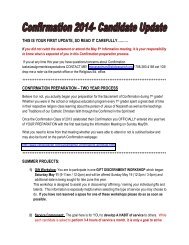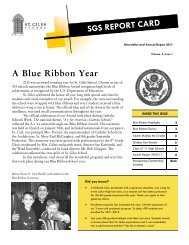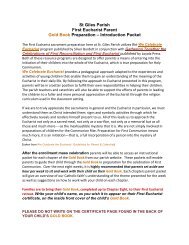First Communion Gold Book Preparation Packet 5 - St. Giles
First Communion Gold Book Preparation Packet 5 - St. Giles
First Communion Gold Book Preparation Packet 5 - St. Giles
Create successful ePaper yourself
Turn your PDF publications into a flip-book with our unique Google optimized e-Paper software.
<strong>St</strong> <strong>Giles</strong> Parish<br />
<strong>First</strong> Eucharist Parent<br />
<strong>Gold</strong> <strong>Book</strong> <strong>Preparation</strong> - <strong>Packet</strong> #5<br />
It is recommended that you and your child choose a day and time that you will set aside each week to<br />
work together with your child’s <strong>Gold</strong> book as preparation for their <strong>First</strong> Eucharist.<br />
Chapter Five—The Eucharist, It’s About Making Peace<br />
Parent’s Introduction to This Week’s Theme:<br />
To help your child realize that in God’s family we are forgiven and reconciled with God and with our<br />
brothers.<br />
-----------------------------------------------------------------------------------------------------------------------------------------<br />
This is a good chapter to review given the parish’s recent <strong>First</strong> Reconciliation celebration with our<br />
sacrament children.<br />
The marvels of contemporary communication, which can bring us joy, peace, and a sense of wonder, can<br />
also make us more fully aware of the countless people whom our modern day technology and<br />
knowledge have unfortunately failed to serve. Our shrinking world offers us a greater opportunity and a<br />
greater responsibility. To live as Christians in a shrinking world is to be struck with the urgency of the<br />
responsibilities that confront us.<br />
From the dawn of Christian history, the unity of God’s people has been accepted as a gift from God. It<br />
was God who formed Israel into one people in the desert. The law that he gave them in the Ten<br />
Commandments was at once a sign of his concern for them and a source of their unity in him. To<br />
transgress his law was to disrupt the community and so to sin against God himself.<br />
When the covenant between God and man was fulfilled in Christ, a new people was formed. Their law<br />
goes far beyond any legal precisions. It is crystallized in the Sermon on the Mount, in the Beatitudes,<br />
which call upon people to share the spirit of Christ---a spirit of love, justice, of truth, of patience, of<br />
forgiveness. To refuse to respond to this call not only weakens the bonds of fellowship but also strains<br />
our relationship with God. We Christians know that whatever we do to build up or tear down the<br />
community of man also profoundly affects our relationship to the Father and creator of all. When we<br />
recognize this fundamental truth, we are taking seriously Christ’s words: “As often as you did it for one<br />
of my least brothers, you did it for me.” (Matthew 25:40)<br />
It should not be at all surprising that our celebration of life together, finds expression in the Eucharist.<br />
The entire Eucharistic liturgy, as the whole of our Christian lives, points toward unity. But particular<br />
elements of the Eucharist liturgy set this concern in relief. These elements are the Penitential Rite, in<br />
which we seek the forgiveness of God and one another for the failure to foster the unity he gives us; the<br />
Prayer of the Faithful, in which we pray for the needs of the family of man; and the Sign of Peace, in<br />
which we signify both the unity we have and the unity we seek in the Eucharist.<br />
Though each of these rites takes place within a different movement of the Eucharistic celebration, they<br />
are profoundly interrelated. In each rite we recognize who we are now and who we are called to be. In
each we admit that we have fallen short of our task, that we are at a distance from our goal, and we<br />
offer a pledge for the future. Through each God speaks to us, offering to restore or strengthen his gift of<br />
unity.<br />
Each rite offers us a way of responding to Christ’s words. “If you bring your gift to the altar and there<br />
recall that your brother has anything against you, leave your gift at the altar, go first and be reconciled<br />
with your brother, and then come and offer your gift.” (Matthew 14:27)<br />
In a world at once more united yet more fragmented than ever, the concern that these rites express and<br />
the promise that they fulfill in the Eucharist should speak to us in a special way. They show us<br />
something of what our Christian Eucharist is really all about: reconciling. And reconciling is making<br />
peace.<br />
(Taken from We Celebrate the Eucharist: Guidelines for Parent and Catechists)<br />
----------------------------------------------------------------------------------------------------------------------------------------<br />
Working with Your Child and their <strong>Gold</strong> <strong>Book</strong><br />
Open this chapter by reviewing your child’s experience of <strong>First</strong> Reconciliation. Ask your child to look at<br />
the pictures on pages 34 of their book. Use the following questions to discuss these pages:<br />
• Ask your child to describe how the boy in the first picture feels.<br />
• What might have caused the boy’s sadness?<br />
• How do you feel toward him?<br />
• What might help him now?<br />
• What do you think happens in the second picture?<br />
• How does he third picture make you feel?<br />
• Have you ever felt the way the boys in this picture feel?<br />
• What is the fourth picture saying?<br />
• -------------------------------------------------------------------------------------------------------------------------<br />
Describe your joy when your child comes to you to ask forgiveness after something has gone wrong.<br />
Explain that parents are willing to forgive their children over and over again because they love them,<br />
and the love they have in their hearts comes from God.<br />
Explain the God is willing to forgive us over and over again when we ask his forgiveness. Use Matthew<br />
18:21-24 to help make you presentation specific and detailed. You may use the following adaptation as<br />
well,<br />
“One day Peter, who was a very good friend of Jesus, came to Jesus and asked, “Lord, how many<br />
times can my brother hurt me and how many times do I have to forgive him? Should I forgive<br />
him seven times?” Jesus looked at his friend Peter and said, “No, not seven times, but seventy<br />
times seven. You should forgive your brother over and over again.”<br />
Then help your child assimilate this story by asking questions such as:<br />
• How do you think Peter felt about Jesus’ words?<br />
• What do you think about Jesus’ words?<br />
• Do you think what Jesus asked Peter is too hard to do? Why? Or Why not?
Reflect with your child for a few minutes on whether we always obey Jesus’ words; whether we are<br />
always ready to forgive and make peace with those who do us wrong. Ask your child to open his book to<br />
page 35. Read the text with him/her. Comment briefly on what you have read, and encourage your<br />
child to express their thoughts. Have them write their answer to the question on page 35 and then<br />
create a drawing showing how they make up after a quarrel.<br />
Read the scripture story found a pages 36 & 37 with your child. Have them explain in their own words<br />
what happened in the story. Relate to your child that God is like the father waiting for us to come home<br />
when we have turned away from Him.<br />
========================================================================<br />
Help your child recall the particular actions—that is, the special prayers, songs, and gestures—that are<br />
part of the liturgical celebration in which people ask forgiveness of God and one another. Explain that<br />
we ask for the Lord’s forgiveness by saying or singing “Lord have mercy.<br />
Read page 38 together and have your child describe what they see in the picture on page 39. Have they<br />
ever experienced what is in the picture on page 39? When?<br />
----------------------------------------------------------------------------------------------------------------------------------------<br />
The Sign of Peace<br />
Read page 40 to your child. Show your child how we give the sign of peace to our brothers and sisters in<br />
God’s house.<br />
Ask your child to illustrate on page 41 the sign of peace that we give to one another in God’s house<br />
during the celebration.<br />
When your child has finished their drawing, ask them to show it to you and tell about it. As always, ask<br />
specific questions will lead to the best verbal expression.<br />
• Who are these people?<br />
• Where are they?<br />
• What are they doing?<br />
• What do they say to one another when they give the Sign of Peace?<br />
------------------------------------------------------------------------------------------------------------------------------<br />
Close by praying the Our Father together followed by the Sign of Peace.<br />
-------------------------------------------------------------------------------------<br />
Have your child keep their <strong>Gold</strong> <strong>Book</strong> in a special place, so they know it is special.<br />
Some books for storytelling that will give fuller meaning to this week’s theme include:<br />
Two is a Team by Lorraine and Jerrald Beim<br />
It’s Mine by Crosby Bonsall<br />
The Hating <strong>Book</strong> by Charlotte Zolotow








